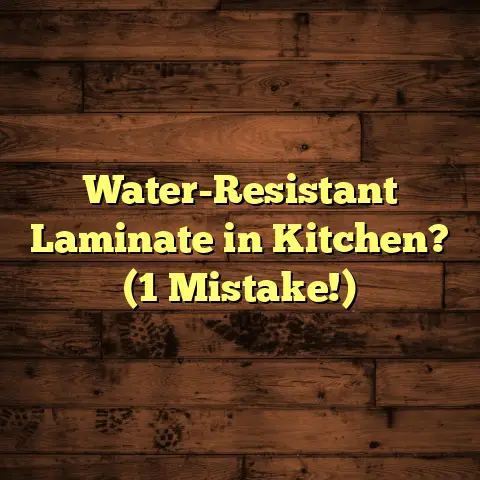Clean Ceramic Tile: What To Use? (1 Tip Pro’s Use!)
I’ve spent years as a flooring contractor, and I’ve seen firsthand how ceramic tile can transform a space. These days, with open floor plans being all the rage, and everyone wanting that magazine- worthy aesthetic, ceramic tile is more popular than ever.
But let’s be real – life happens! Kids, pets, spills… it all takes a toll. And that beautiful tile can quickly lose its luster if you don’t keep up with cleaning. Not to mention the health benefits. A clean floor means fewer allergens and bacteria floating around, contributing to a healthier home.
So, how do you keep those ceramic tiles sparkling? What are the best products and techniques? And what’s the one trick that pros like me swear by? Let’s dive in!
Section 1: Understanding Ceramic Tiles
First, let’s get down to basics. What exactly is ceramic tile?
Simply put, it’s a mixture of clay, minerals, and water that’s molded, then fired at high temperatures. This process makes it hard, durable, and resistant to water.
There are a few main types you’ll come across:
-
Glazed Ceramic Tile: This is probably what you picture when you think of ceramic tile. It has a glass-like coating that’s applied and fired onto the surface. This glaze can be virtually any color or pattern, and it makes the tile waterproof and stain-resistant.
-
Unglazed Ceramic Tile: As the name suggests, this type doesn’t have a glaze. It’s more porous than glazed tile, so it’s more susceptible to staining and water damage. However, it often has a more natural, rustic look, and it can be more slip-resistant.
-
Porcelain Tile: Okay, this one’s a bit of a gray area. Porcelain is technically a type of ceramic tile, but it’s made with finer clay and fired at even higher temperatures. This makes it denser, harder, and even more water-resistant than standard ceramic tile.
Why choose ceramic tile for your home? I’ve seen it all, and here’s what I tell my clients:
-
Durability: Ceramic tile can last for decades with proper care. It’s resistant to scratches, dents, and fading.
-
Water Resistance: Especially glazed tile, is perfect for bathrooms, kitchens, and other areas prone to moisture.
-
Stain Resistance: Most spills can be easily wiped up without leaving a permanent mark.
-
Versatility: The sheer variety of colors, patterns, and sizes available means you can find a ceramic tile to suit any style.
Section 2: The Importance of Cleaning Ceramic Tiles
Okay, so you’ve got beautiful ceramic tile floors. Now what?
Cleaning isn’t just about aesthetics. It’s about protecting your investment and maintaining a healthy home.
Think about it: dirt, grime, and spills can all accumulate on the surface of your tile. Over time, this can lead to:
-
Discoloration: That bright, clean tile can start to look dull and dingy.
-
Grout Stains: Grout is porous, so it easily absorbs stains. Once grout is stained, it can be tough to get it looking new again.
-
Surface Damage: While ceramic tile is durable, it can still be scratched or etched by abrasive cleaners or rough scrubbing.
Neglecting tile maintenance can also impact your health. According to the EPA, indoor air quality can be significantly affected by dirty surfaces. Dust, allergens, and bacteria can accumulate on floors, contributing to respiratory problems and other health issues. A study published in the “Journal of Environmental Health” found that regular cleaning can reduce the levels of allergens in the home by up to 90%.
Plus, let’s not forget the mental well-being aspect. I know it sounds a bit out there, but a clean home really can improve your mood and reduce stress. Think about how you feel when you walk into a clean, organized space versus a cluttered, dirty one.
Section 3: What To Use for Cleaning Ceramic Tiles
Alright, let’s get to the nitty-gritty: what should you actually use to clean your ceramic tile?
There are a ton of options out there, and it can be overwhelming. Here’s a breakdown of some common choices:
-
Commercial Tile Cleaners: These are specifically formulated for cleaning ceramic tile and grout. They often contain detergents, solvents, and other ingredients that help to break down dirt and grime.
- Pros: Effective, convenient, readily available.
- Cons: Can be expensive, may contain harsh chemicals, can leave a residue if not rinsed properly.
-
DIY Solutions: You can make your own tile cleaner using common household ingredients.
-
Vinegar: A mild acid that can help to dissolve dirt and mineral deposits. Mix 1/2 cup of white vinegar with a gallon of warm water.
- Pros: Inexpensive, readily available, environmentally friendly.
- Cons: Can have a strong odor, may not be effective on tough stains, should not be used on natural stone tile.
-
Baking Soda: A mild abrasive that can help to scrub away stains. Make a paste of baking soda and water.
- Pros: Inexpensive, readily available, non-toxic.
- Cons: Can be messy, requires some elbow grease, may scratch delicate surfaces.
-
Dish Soap: A gentle cleaner that can remove grease and grime. Use a small amount of dish soap in a bucket of warm water.
- Pros: Inexpensive, readily available, effective on grease.
- Cons: Can leave a residue if not rinsed properly, may not be strong enough for tough stains.
-
-
Natural Alternatives: If you’re looking for eco-friendly options, there are several natural cleaners you can use.
-
Lemon Juice: Similar to vinegar, lemon juice is a mild acid that can help to dissolve dirt and mineral deposits.
- Pros: Smells great, environmentally friendly.
- Cons: May not be as effective as stronger cleaners, can be acidic and potentially damage certain surfaces.
-
Essential Oils: Some essential oils, like tea tree oil and eucalyptus oil, have antiseptic and antibacterial properties. Add a few drops to your cleaning solution.
- Pros: Smells great, natural disinfectant.
- Cons: Can be expensive, may not be effective on all types of stains.
-
When choosing a cleaning product, always consider:
-
The type of tile you have: Some cleaners are not suitable for certain types of tile. For example, acidic cleaners like vinegar can damage natural stone tile.
-
The type of stain you’re dealing with: Some stains require stronger cleaners than others. For example, grease stains may require a degreaser.
-
Your personal preferences: Do you prefer natural cleaners or commercial cleaners? Do you have any allergies or sensitivities to certain chemicals?
Section 4: The One Tip Pros Use
Okay, here it is… the one tip that I and many other flooring pros swear by for cleaning ceramic tile:
Use a Neutral pH Cleaner.
I know, it doesn’t sound super exciting, but trust me, it makes a huge difference.
Here’s why:
Most ceramic tile is pretty resilient, but the grout between the tiles is a different story. Grout is porous, meaning it has tiny holes that can absorb liquids and stains.
Acidic cleaners (like vinegar or lemon juice) can etch and damage grout over time. Alkaline cleaners (like bleach) can also be harsh and can discolor grout.
A neutral pH cleaner, on the other hand, is gentle enough to use on both the tile and the grout without causing any damage. It effectively removes dirt and grime without stripping away the grout’s sealant or altering its color.
Think of it like this: you wouldn’t use harsh chemicals on your skin every day, would you? You’d use a gentle cleanser that’s designed to clean without irritating. The same principle applies to your ceramic tile floors.
So, how do you implement this tip in your cleaning routine?
Here’s a step-by-step guide:
-
Choose a Neutral pH Cleaner: Look for a cleaner that’s specifically labeled as “neutral pH” or “pH balanced.” You can find these at most hardware stores or online.
-
Prepare Your Cleaning Solution: Follow the instructions on the cleaner’s label to dilute it properly. Usually, it involves mixing a small amount of cleaner with water.
-
Apply the Solution: Use a mop, sponge, or cloth to apply the cleaning solution to your ceramic tile floor.
-
Let it Sit: Allow the solution to sit on the floor for a few minutes to loosen dirt and grime.
-
Scrub (If Necessary): If you have stubborn stains or buildup, use a soft-bristled brush or sponge to gently scrub the affected areas.
-
Rinse Thoroughly: Rinse the floor with clean water to remove any remaining cleaner.
-
Dry the Floor: Use a clean, dry mop or cloth to dry the floor. This will help to prevent water spots and streaks.
Section 5: Cleaning Techniques and Tools
Now that you know what to use, let’s talk about how to use it. Having the right tools and techniques can make a big difference in how effectively you clean your ceramic tile.
Here are some essential tools:
-
Mops: A good mop is essential for cleaning large areas of tile. I prefer microfiber mops because they’re absorbent, gentle, and easy to clean. Sponge mops are also a good option, but they can be more difficult to wring out.
-
Scrub Brushes: A scrub brush is helpful for cleaning grout lines and tackling stubborn stains. Look for a brush with stiff, nylon bristles.
-
Microfiber Cloths: Microfiber cloths are great for wiping up spills, dusting, and polishing tile. They’re super absorbent and won’t scratch the surface.
-
Buckets: You’ll need at least one bucket for holding your cleaning solution and another for rinsing your mop or cloth.
-
Vacuum or Broom: Before you start cleaning, it’s important to remove any loose dirt, dust, and debris from the floor. A vacuum or broom works well for this.
Here are some effective cleaning techniques:
-
Wet Mopping: This is the most common method for cleaning ceramic tile floors. Simply dip your mop into your cleaning solution, wring it out well, and mop the floor in overlapping strokes. Be sure to rinse your mop frequently to avoid spreading dirt around.
-
Dry Dusting: Dry dusting is a great way to remove loose dirt and dust from your tile floors in between wet moppings. Use a microfiber dust mop or cloth to dust the floor regularly.
-
Targeted Scrubbing: For tough stains, you may need to do some targeted scrubbing. Apply a small amount of cleaner directly to the stain, let it sit for a few minutes, and then scrub with a scrub brush or sponge.
Here are a few common mistakes to avoid:
-
Using Abrasive Cleaners: Abrasive cleaners can scratch and damage ceramic tile, especially glazed tile. Avoid using scouring powders, steel wool, or other abrasive materials.
-
Using Too Much Water: Too much water can seep into the grout lines and cause mildew to grow. Be sure to wring out your mop or cloth well before cleaning.
-
Neglecting the Grout: Grout is often the dirtiest part of a tile floor. Be sure to pay special attention to the grout lines when you’re cleaning.
Section 6: Maintaining Clean Ceramic Tiles
Cleaning is important, but prevention is even better! Here are some things you can do to keep your ceramic tile clean longer:
-
Use Mats: Place mats at entrances to trap dirt and debris before they get tracked onto your tile floors.
-
Regular Sweeping: Sweep or vacuum your tile floors regularly to remove loose dirt and dust.
-
Prompt Spill Management: Clean up spills immediately to prevent them from staining or damaging your tile.
-
Seal Your Grout: Sealing your grout helps to prevent it from absorbing stains and dirt. Apply a grout sealer every year or two, or as needed. I recommend using a high-quality penetrating sealer.
Here’s a sample cleaning schedule you can follow:
-
Daily: Sweep or vacuum your tile floors to remove loose dirt and dust. Wipe up any spills immediately.
-
Weekly: Mop your tile floors with a neutral pH cleaner.
-
Monthly: Deep clean your grout lines with a grout brush and a grout cleaner.
-
Annually: Reseal your grout lines.
Conclusion
So, there you have it! Everything you need to know about cleaning ceramic tile.
Remember, maintaining clean ceramic tiles isn’t just about aesthetics. It’s about protecting your investment, promoting a healthy home, and improving your overall quality of life.
By using the right products, techniques, and preventive measures, you can keep your ceramic tile floors looking their best for years to come. And don’t forget that one key tip: use a neutral pH cleaner! It’s the secret weapon that pros like me rely on for gentle, effective cleaning.
Now, go forth and conquer those dirty tiles! You’ve got this!





